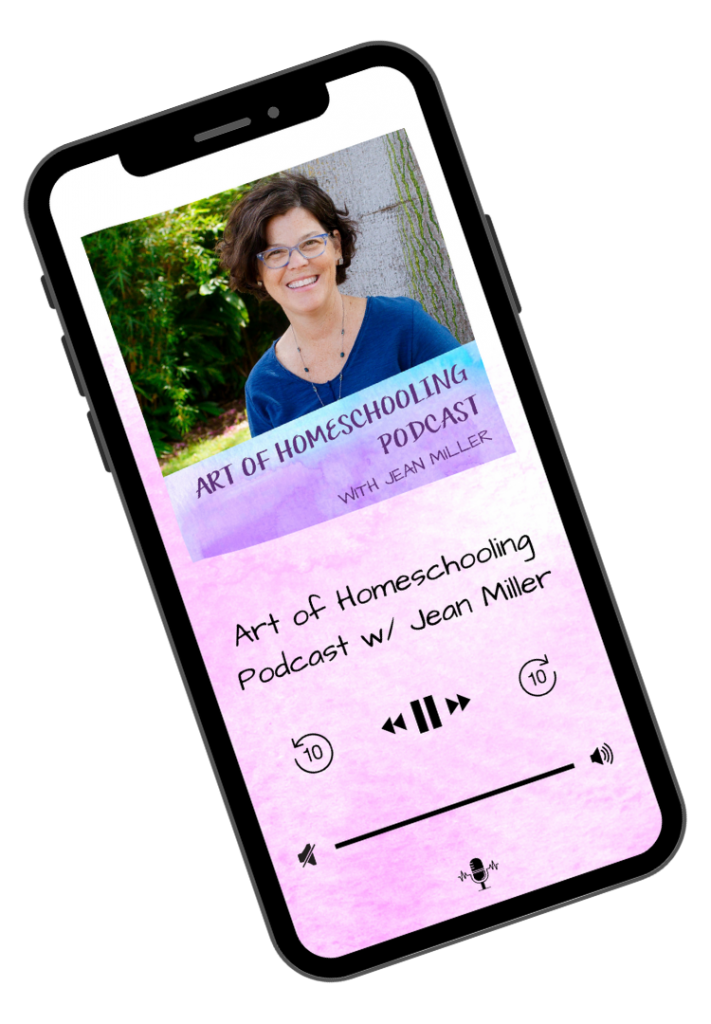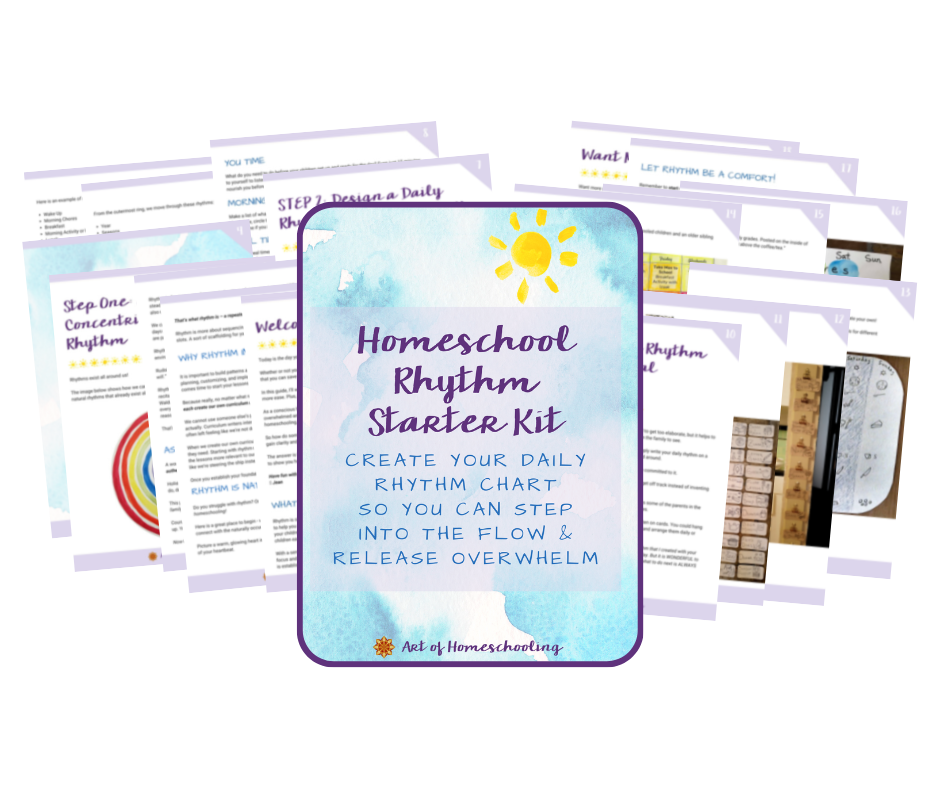Episode 149
Rhythm is a hot topic around here at the Art of Homeschooling! And today, I want to talk about the rhythm of family mealtimes.
So often when we start a new homeschooling year, or return after a holiday or vacation, re-establishing a smoothly flowing daily rhythm starts with anchor points during the day like mealtimes and bedtime.
Anchor points provide a framework for your daily rhythm. And are really the BEST place to start when you want to bring back balance, consistency, and connection in family life.
The flexibility that homeschooling provides can be wonderful, but also challenging when it’s time to return to or establish a daily rhythm.
Here in this episode of the podcast, I want to share some ideas and resources to support the rhythm of family mealtimes.
This post contains referral links which means I may earn a commission from products you purchase via those links at no additional cost to you. You can read my full disclosure policy here.
Anchor Points throughout Your Day
The phrase anchor points comes from the Simplicity Parenting movement.
Anchor points are simply the activities that happen naturally in your day that can anchor your daily rhythm.
We and our children ~ our families ~ benefit from the consistency and connection of anchor points throughout the day. Without anchor points, we can feel anxious, overwhelmed, or out of control. This is the “soul fever” that Kim John Payne refers to in his book, Simplicity Parenting.
The rhythm of these repeated anchor points can provide predictability, a sense of safety and stability, and freedom from stress for your family with minimal effort once you get it flowing. Rhythm helps us move through the day from one activity to the next with an ease, a flow, and a sense of calm.
Now I know that meal times aren’t always stress-free!
But there are things we can do to reduce the stress. And believe me when I tell you that it’s so worth it to make the effort. Because when you hold the value of mealtimes as important to you and your family, this sense of sacred time and connection will grow through the years.
Family Mealtimes
When our boys were little ~ and keep in mind that they’re just 16 months apart ~ our mealtimes would devolve rather quickly into whining, squirming, or even arguing. I remember a time when I thought that 10 or 15 minutes at the dinner table was a win!
But I didn’t give up. And that length of time around the table grew. We even reached a point where everyone in the family played a role in preparing to eat together ~ setting the table, making the food, lighting a candle, leading a blessing, clearing the table, and washing the dishes. With everyone pitching in, we built up a sense of creating this ritual of mealtimes together.
By the time my oldest was in college ~ and he went to school nearby ~ our house had become the place for his 20-something friends to come for dinner and holiday meals. What a joy it was to sit around the table with these interesting young adults to share food and talk for hours.
And here’s something that’s still true for me today: whenever I go through a crazy season, or the holidays are over, or when the end of summer arrives, the place I always start in order to get things back on track is with the rhythm of mealtimes.
Even though it’s only Brian and me nowadays, I still do some meal planning, clean out the fridge, buy new candles for the table, and make an effort to get back to having healthy and regular mealtimes if our healthy habits have slipped during a busy season or holidays.
Meal Planning
While I’ve always honored dinnertime as a special family gathering, I wasn’t always inspired or organized with what to make for the meal after a day of homeschooling with three kiddos.
I tried collecting binders of recipes, meal planning on blank templates, and even jotting down ideas on a calendar. But for years, I felt chaotic around meal planning and dinners especially.
The worst is when 4pm arrives, we’re exhausted, and we have no idea what to make for dinner.
When I discovered my current meal planning system, that all changed. I’ve been using this tool for TEN years and love it so much. It’s an online app designed to ease the burden of meal planning so you can enjoy dinner with your family.
With Plan to Eat, you can save recipes from the web with just the URL or you can also add your own favorite recipes. Then you simply drag and drop recipes into your meal planning calendar. From there, you can generate your shopping list for the week.
One of my favorite strategies is to set up a “menu” for the week and then keep reusing that collection of recipes in future weeks. Create 3 weeks of healthy meal plans and just keep rotating through them ~ how simple is that!
Check out Plan to Eat here ~ they have a 14-day free trial.
Plan to Eat makes it so much easier to plan family dinners. For me, this tool has helped me ~ and my family ~ eat healthier, spend less time meal planning, and feel more relaxed knowing what’s for dinner ahead of time.
Kids in the Kitchen
Another of my favorite resources to get kiddos more involved in meal preparation is Kids Cook Real Food. It’s a cooking curriculum for the whole family where children can learn key life skills and start to help you in the kitchen. Cooking together is so connecting!
This cooking curriculum is video based and shows parents and kids working together in the kitchen, giving you specific recipes to make together.
A few other resources from Kids Cook Real Food include:
- No More Picky Eating Challenge in September
- Beyond Baking Cookies webinar in November
- Holiday Baking Challenge through the holidays
Ideas for Stress-Free & Fun Mealtimes
- Start simple and easy. Two super simple chores to have children participate in are setting the table and unloading the dishwasher.
- Keep mealtime grumpiness at bay. Weekday meals at the end of a long day can be challenging! Especially if there is a parent who works outside the home who’s tired and maybe cranky themselves and not especially interested in leading an engaging conversation or listening to lots of chatter. AND you, as the parent at home, are also wishing for a break!
To keep family meals from devolving, try simple games or conversation starters. Brain Quest Q&A decks are super fun! Just toss out a question every so often while you’re all nibbling away. Or family dinner games cards or chat packs.
- Other conversation games like 20 Questions or Guess My Number are also fun.
- Play Where Did It Come From? and discuss how each of your food items made their way to your table. Thank the farmers, gardeners, factory workers, truckers, store clerks, animals, plants, and the sun for the nourishment!
- Play Rose, Thorn, Bud ~ go around the table and ask each person to share a beautiful thing from their day or week, one thorny thing, and something they’re looking forward to.
More Resources
Other podcast episodes you might be interested in listening to:
- Episode #114: Find Your Daily Anchor Points
- Episode #64: Mealtime Blessings
“Food is the ingredient that binds us together.”
May the rhythm of mealtimes in your family be fun and memorable. 🏠💗
Rate & Review the Podcast
If the Art of Homeschooling Podcast has inspired you, I’d LOVE it if you could rate and review the podcast on your favorite podcast player! Reviews can be left on Apple Podcasts (iTunes), Podcast Addict, or Stitcher.
Or simply pop on over to lovethepodcast.com/artofhomeschooling and choose where you want to leave your review.
And if you want to show your appreciation for the Art of Homeschooling Podcast, you can buy me a coffee!
Never Miss an Episode!


Check Out All the Episodes Here




